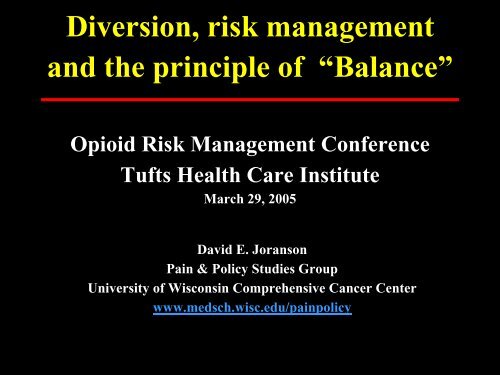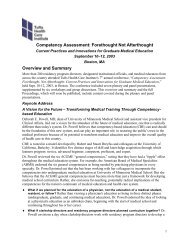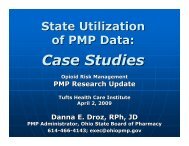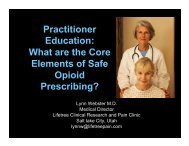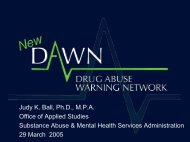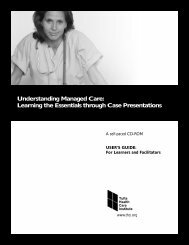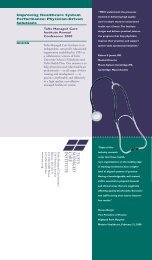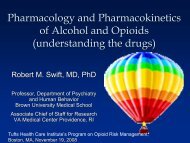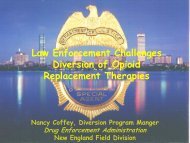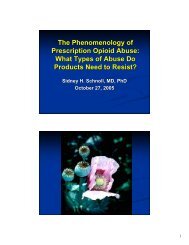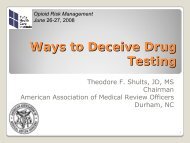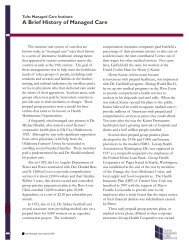Presentation - Tufts Health Care Institute
Presentation - Tufts Health Care Institute
Presentation - Tufts Health Care Institute
Create successful ePaper yourself
Turn your PDF publications into a flip-book with our unique Google optimized e-Paper software.
Diversion, risk management<br />
and the principle of “Balance”<br />
Opioid Risk Management Conference<br />
<strong>Tufts</strong> <strong>Health</strong> <strong>Care</strong> <strong>Institute</strong><br />
March 29, 2005<br />
David E. Joranson<br />
Pain & Policy Studies Group<br />
University of Wisconsin Comprehensive Cancer Center<br />
www.medsch.wisc.edu/painpolicy
Aims<br />
• What is a “balanced” approach to<br />
diversion and risk management<br />
– National policy framework<br />
– Outcomes of a balanced approach<br />
– Roles of clinicians and law enforcement<br />
• Are aiming in the right direction<br />
– All sources of diversion<br />
– A public health approach
Consequences of diversion<br />
• Illicit availability of prescription drugs<br />
• Secondary crime<br />
• Misuse, abuse, addiction/drug dependence<br />
• Morbidity and mortality<br />
• Reduced confidence in medications<br />
• Reluctance to prescribe<br />
• Reduced patient access to care<br />
• Exacerbation of pain
National Policy Framework<br />
• States-regulate professional practice; diversion inv.<br />
• FDA-regulates drug approval<br />
Efficacy and safety<br />
• CSA<br />
Control system; registration; penalties; diversion inv.<br />
Necessary for public health<br />
Not for addiction; OK for ‘intractable’ pain<br />
Availability ensured<br />
HHS medical and scientific decisions binding on DEA<br />
scheduling<br />
Pain & Policy Studies Group
The Principle of “Balance”<br />
• Opioids safe and effective; necessary<br />
• Potential for abuse; control system<br />
• Medical value of approved drugs unchanged<br />
• Controlled substance policy not to conflict with<br />
medicine<br />
• Efforts to address abuse and diversion must not<br />
interfere with medical practice and patient care<br />
Pain & Policy Studies Group
Recognition of need for Balance<br />
• <strong>Institute</strong> of Medicine<br />
• American Cancer Society<br />
• National Cancer <strong>Institute</strong><br />
• Federation of State Medical Boards<br />
• American Medical Association<br />
• Drug Enforcement Administration<br />
• International Narcotics Control Board<br />
• World <strong>Health</strong> Organization<br />
• European Union<br />
Pain & Policy Studies Group
Outcomes of a “balanced” approach<br />
• Sources of diversion are identified and<br />
resolved<br />
• No interference in medical practice or<br />
patient care<br />
Pain & Policy Studies Group
Roles of clinicians and law enforcement<br />
CLINICIANS<br />
LAW ENF./REG.<br />
Primary<br />
• Evaluate patients’<br />
pain<br />
• Relieve pain<br />
• Evaluate sources of<br />
diversion<br />
• Stop diverters<br />
Secondary<br />
• Know about<br />
diversion<br />
• Avoid contributing to<br />
diversion<br />
• Know about pain<br />
management<br />
•Avoid interfering in<br />
medicine and patient<br />
care<br />
Pain & Policy Studies Group
Balanced Approaches<br />
• Educate clinicians about risk assessment<br />
• Stop internet availability of opioids<br />
• Stop pharmacy crime<br />
• Identify doctor-shoppers<br />
• Identify prescribers who divert<br />
• Reduce demand<br />
Are we doing this<br />
Pain & Policy Studies Group
Unbalanced approaches<br />
• Don’t stock it<br />
• Reduce the dose<br />
• Discontinue patients<br />
• Refer pain patients to specialists<br />
• Contracts and urinalysis for all<br />
patients<br />
Are we doing this<br />
Pain & Policy Studies Group
How to achieve balanced outcomes<br />
1. Use existing information to identify sources<br />
– Medicaid<br />
– Pharmacy theft<br />
– PMP<br />
2. Intervene<br />
– Educate, treat, decertify, lock-in, discipline,<br />
criminal charges<br />
– Proportionate responses<br />
3. Evaluate outcomes for effectiveness and safety<br />
Are we doing this
US GAO: Use Medicaid<br />
to address diversion<br />
1983 “Prescription Drug Abuse and<br />
Diversion in the Medicaid Program”<br />
1988 “Controlled Substances: Medicaid<br />
Data May Be Useful for Monitoring<br />
Diversion”<br />
1997 “States Can Readily Identify Illegal<br />
Sales and Use of Controlled<br />
Substances”<br />
Do all states use Medicaid data to detect diversion
Pharmacy theft in the USA<br />
1984: Congress makes pharmacy theft a federal crime<br />
2002: > 45 pharmacy thefts in Boston area<br />
00-03: 2,494 thefts of Oxycontin<br />
631 armed robberies<br />
707 night break-ins;<br />
1,369,667 dosage units diverted<br />
2004: “the number of pharmacies reporting drug losses due<br />
to breaking and entering has increased.”
We need a public health approach<br />
to diversion<br />
• Evaluate all the sources (“vectors”)<br />
• Examine existing data bases and their uses<br />
• Prioritize according to severity<br />
• Plan interventions<br />
• Use appropriate authority<br />
• Avoid unintended consequences<br />
• Evaluate outcomes<br />
Are we there yet


